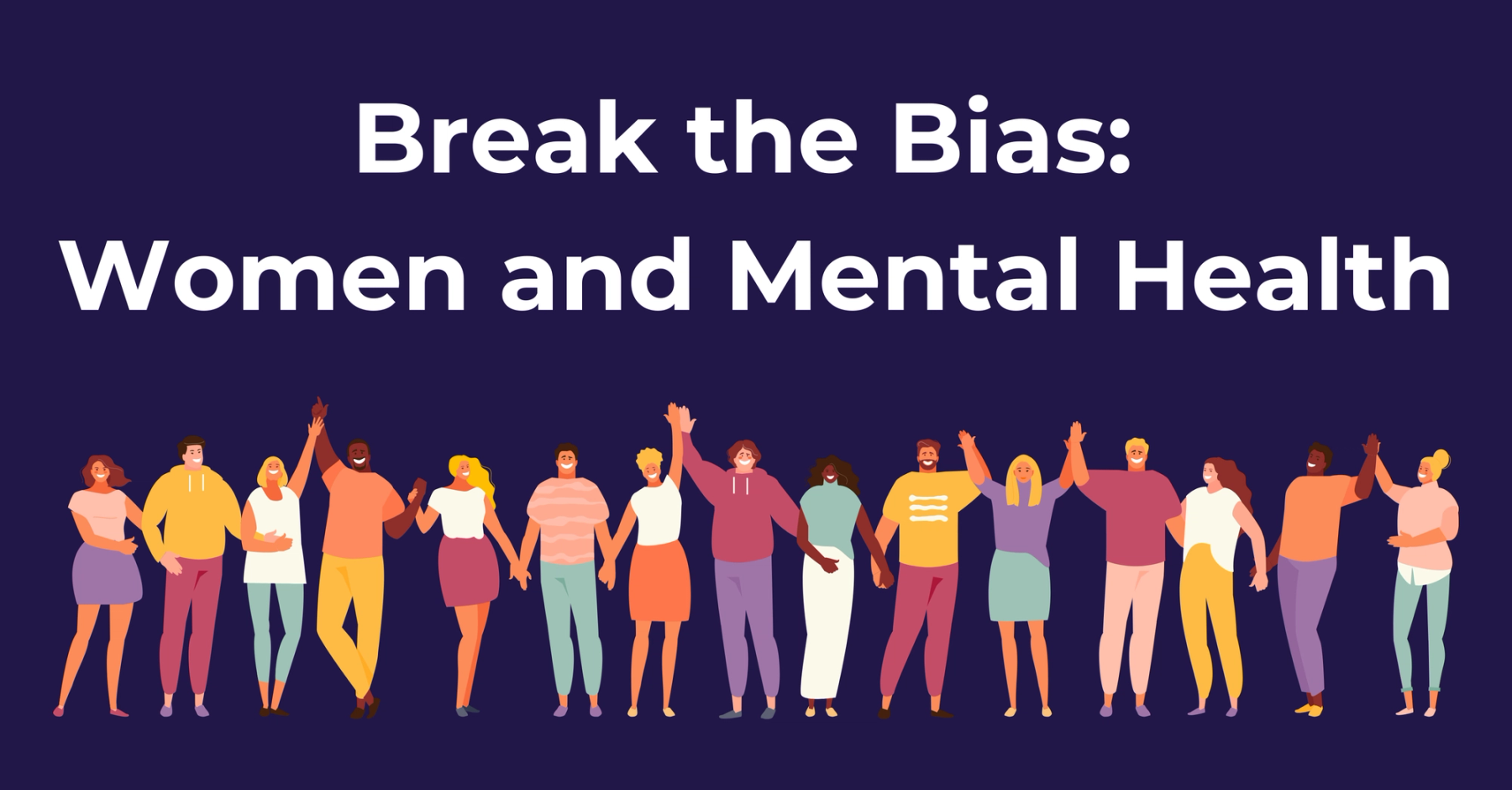March 8th, 2022

Thinking about the many ways in which biases surrounding women plague society evokes an incredible array of emotions. It is undeniable that throughout history, women have faced innumerous challenges as a result of stereotypes, prejudices, and inequality. Furthermore, this has been especially true for women who are BIPOC and/or LGBTQ+.
This year’s International Women’s Day theme is highlighting the idea of breaking biases- the ways that we all can “challenge stereotypes, fight bias, practice acceptance, broaden our minds, call out inequality.” The mind can easily become flooded with ways in which these goals can be enacted in everyday life.
Before moving too far in though, it is important to understand the definition of ‘bias’. Oxford Languages defines ‘bias’ as: “prejudice in favor of or against one thing, person, or group compared with another, usually in a way considered to be unfair” (2).
In researching this year’s theme of breaking the bias and its interconnectedness with women’s mental health, there were about 31,000,000 results within less than one second - 0.49 seconds to be exact. The amount of information, articles, and discussions that are readily available at our fingertips is mindblowing. Especially when we consider that this was not always the case.
As a mental health therapist, a large part of my training has centered around becoming ‘trauma-informed’. This is the perspective that each person coming into the therapy space has a unique story, full of many experiences whether including ‘Big T trauma’ or not, and it is the therapist’s job to practice sensitivity towards this through prioritizing emotional and psychological safety. In the past several decades, the field of research on ‘trauma’ and ‘trauma-informed care’ has grown exponentially. However, yet again, this was not always the case.
This idea was highlighted in depth throughout the first chapter of Judith Herman’s, “Trauma and Recovery: The Aftermath of Violence- From Domestic Abuse to Political Terror.” In summation, Herman synthesizes three major areas of inquiry in relation to trauma, the corresponding political movements subsequently occurring in tandem, and the overarching theme of breaking the bias which has contributed towards paving the way for change and equity in the mental health field.
The first wave of inquiry Herman cited was in the latter decades of the 1800s when physicians began seriously reconsidering the treatment plan for hysteria. This was a term coined for what was considered a “strange disease with incoherent and incomprehensible symptoms…believed to be a disease proper to women and originating in the uterus” (3). After decades of research and drastic retaliation against archaic biases, pioneering physicians (Charcot, Janet, and Freud) were able to advance the concept that those afflicted by hysteria were experiencing psychological symptoms, were not, in fact, malingering (common belief back then…and yet, still contemporarily relevant), and the proper intervention in treating this condition was to talk with the women they were studying and to listen. In doing so, by the mid-1890s, both Janet and Freud found that hysteria was the result of psychological trauma and that “symptoms could be alleviated when the traumatic memories, as well as intense feelings that accompanied them, were recovered and put into words” (4).
The next wave of inquiry that occurred in the mental health field did not directly involve women, however, the movement helped to further progress the trauma-informed mental health services that were shown to have promising effects in the late-nineteenth century.
Herman went on to describe the second wave of inquiry which kicked off with the First World War and continued sporadically through the Second World War and the Vietnam War. It was observed during the First World War, “under conditions of unremitting exposure to the horrors of trench warfare, men began to break down in shocking numbers” (5). Initially, Charles Myers- a British psychologist- attributed these ‘breakdowns’ to “shell shock” (“concussive effects of exploding shells” (6)); however, it was found that this presentation could also be found in soldiers who were not exposed to physical attacks. This resulted in a new term, ‘combat neurosis’.
However, as Herman noted, once acknowledgment of this disorder was determined, biases quickly then transformed to attacking the “moral character of the patient” where it was unfairly posited that soldiers who suffered from combat neuroses were “inferior”, “malingering”, and other cruel names (7). In protest of these unfair biases, medical professionals in the field argued the progressive stance that soldiers deserved humane treatment, treated with dignity and respect, and encouraged to write and talk freely about the terrors of war (8). These tenets of treatment with soldiers were shown to, yet again, have promising results.
During the Second World War, Herman noted that the use of the ‘talking cure’ (allowing those that are suffering to simply talk about their suffering to bring about emotional and psychological catharsis) as the primary method of treatment was once again utilized, and now, in a revolutionary advancement, paired with attempts to minimize the separation of soldiers who are afflicted with combat neuroses and their comrades (9). However, due to the systems in place, it was found that 80% of soldiers were often returned to duty within one week (10) and soldiers were left to carry the burden of war on their own, both in combat zones as well when they returned home.

Moving forward in time, during the height of the Vietnam War, soldiers banded together to create ‘Vietnam Veterans Against the War’ (11) to highlight the failures of the treatment attempts made in the Second World War and grow the camaraderie between those that shared experiences of horrific and painful memories. These individuals worked together to demonstrate the inherent truth and benefit of interconnectedness.
By the mid-1970s, the small group that was originally created eventually grew and broke off into hundreds of antiwar groups called ‘rap groups’ (12). In these spaces, Veterans, along with psychiatrists who identified with the antiwar movement that could offer clinical insight, came together to process the experiences of war. By the end of the 1970s, these efforts continued with support groups, outreach centers, and peer counseling programs run by Veterans that were developed as a part of Operation Outreach under the Veterans’ Administration (referred to as ‘VA’ moving forward) (13).
Finally, in 1980, Herman reported that, after years of studies conducted by the VA, the American Psychiatric Association finally included ‘Post-Traumatic Stress Disorder’ in the Diagnostic and Statistical Manual of Mental Disorders (14). The “characteristic syndrome of psychological trauma had officially become a ‘real’ diagnosis”, with congruent features to those observed by physicians during the late 1800s with hysteria and in the 1940s during the Second World War.
The third wave of inquiry on psychological trauma, and breaking the traditional biases that accompany it, was kicked off by the women's liberation movement of the 1970s. Advocates of this movement began acknowledging that “the most common of the post-traumatic disorders are those not of men in war but women in civilian life” (15). This proposition stated that due to societal norms, biases, and the structure of power, those most vulnerable to domestic and sexual exploitation (women and children) lacked a space to acknowledge - let alone share - these atrocities which only caused further victimization and subsequent suffering. This idea advanced the observations of the women studied in the late 1800s who suffered from the affliction formerly known as hysteria, which could now be better coined ‘post-traumatic stress disorder’. Herman noted that the initial method for this movement was termed ‘consciousness-raising’ (16) because, before this period, there was not a “name for the tyranny of private life” (17).
During the consciousness-raising efforts of the women’s liberation movement, groups began to form similar to the rap groups from the Vietnam War. These groups helped women to “overcome the barriers of denial, secrecy, and shame that prevented them from naming their injuries” (18). Furthermore, Herman noted that, although these consciousness-raising groups were to enact change on an individual level, these groups were largely attempting to create change on a larger scale, “to take collective action” (19).
As the years passed and efforts continued to blaze on, there was an increase in public awareness regarding domestic and sexual violence. Specifically, in 1971, the first public speak out on rape was organized by the New York Radical Feminists and in 1976, the first International Tribunal on Crimes Against Women was held in Brussels (20). In 1975, the National Institute on Mental Health began research on rape after pressure from advocates of the movement. Moreover, by the mid-1970s, rape reform legislation was finally launched by the US National Organization for Women and within a decade, reforms were enacted in all fifty states (21).
On another level, the women's liberation movement created change in the way that, as a society, we define, acknowledge, and respond to rape/sexual assault while also highlighting tangible ways to advocate for the survivors. For the first time in history, according to Herman, women redefined rape as a crime against violence aimed to achieve power, subordination, and control rather than a sexual act (22). Another huge advancement in this movement was the opening of the first rape crisis center in 1972 and within a decade, hundreds more centers popped up all over the country (23). Also, in 1972, Ann Burgess (psychiatric nurse) and Lynda Holmstrom (sociologist) began their study of the psychological effects of rape at Boston City Hospital and ultimately coined the phrase ‘rape trauma syndrome’ (24).
Equally important to note, the works of the women’s liberation movement were not limited to inquiries of sexual violence. The movement also entailed an investigation of and work in progressing awareness and change towards domestic violence and violence against children. For example, during the women’s liberation movement and advancement efforts, Lenore Walker (psychologist) coined the initial term ‘battered woman syndrome’ while investigating women who fled their homes to a shelter (25).
In summation, these three waves of inquiry as outlined by Judith Herman- “The Heroic Age of Hysteria”, “The Traumatic Neuroses of War”, and “The Combat Neuroses of the Sex War”- were monumental in the history of the mental health field and their contributions to breaking the biases and stigma surrounding psychological trauma.
Each wave had a significant role in incrementally breaking the biases and stigmas held within society, and sadly even within those who are a part of the mental health field. The original wave that served as a historical catalyst for change was the investigation of women who were deemed as ‘hysterical’ and thus shunned from public spheres of life. The change began when those women spoke out and instead were listened to and offered the opportunity to speak of the horrific experiences they had to endure. The proponents of this work identified that the womens’ suffering was the result of traumatic experiences rather than some moral shortcomings which were also monumental in and of itself.
This inquiry was further advanced by the veterans serving in the multiple wars that occurred during the majority of the twentieth century. The second wave, which included the examination of veterans and the effects of war, demonstrated continued benefits of including the “talking cure” in the treatment of individuals and the clinical recognition of the effects of trauma on an individual’s emotional/physical functioning as being a legitimate diagnosis, “Post-Traumatic Stress Disorder.”
Lastly, the third wave which included the women’s liberation movement highlighted the need for change not only in how the mental health field identifies and responds to individuals experiencing a particular affliction but also on a systemic level. This included not only a paradigm shift in how society defines the atrocities of domestic and sexual violence but also how society works to enact protections and change through legislation and policy reform.
All in all, it is important to concisely point out some of how Judith Herman’s synthesis of historical information can inform us all to break the bias.

Written By: Marialaina Bucci, LCPC, NCC, CDVP, CCTP
References:
At Clarity Clinic, we have highly trained staff who specialize in therapy and psychiatry services. To learn more about how we can support your mental health, call Clarity Clinic on (312) 815-9660 or schedule an appointment today.
Our Services
Virtual/Online CarePHP and IOPAdult PsychiatryChild & Adolescent PsychiatryAdult TherapyChild & Adolescent TherapyCouples CounselingFamily TherapyGroup TherapyPsychological TestingTranscranial Magnetic Stimulation (TMS)